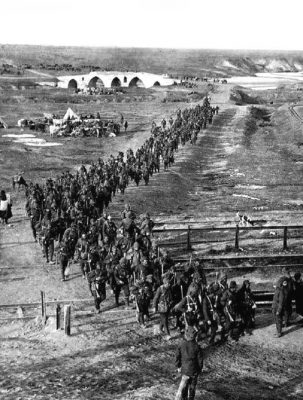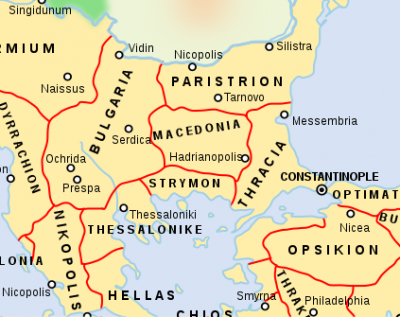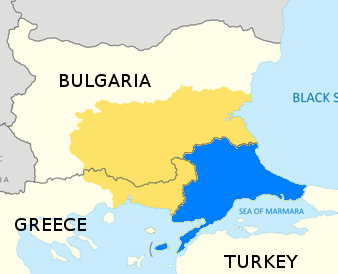Toponym
By 1000 B.C. the area was a Phrygian-Greek colony named Tzirallum, Tzirallun, or Tzirallon (Τζίραλλον).
During Roman and Byzantine times, the town was referred to as Tzouroulos (Tsurulos), or Syrallo. The spelling ‘Zorolus’ is used for the Latinized form of the name of the episcopal see identified with present-day Çorlu in the Catholic Church’s list of titular sees. Some writers have identified the Roman town of Caenophrurium (the stronghold of the Caeni and the place where Emperor Aurelian was murdered in 275) with Çorlu, but this seems unlikely as the Antonine Itinerary lists Cenofrurium as two stages and 36 miles closer to Byzantium than Tzirallum, and the Tabula Peutingeriana shows the locations separately.
History

Bronze Age relics have been found in various areas of Thrace including Çorlu. The area was subsequently controlled by Greeks, Persians, Romans and the Byzantines.
Following a tumultuous early history, Çorlu was brought under Ottoman control by Sultan Murad I, who immediately ordered the destruction of the Roman walls as part of a policy of opening up the town under Pax Ottomana. In the Ottoman period, the town remained an important staging post on the road from Constantinople to Greece.
In the late 18th century, when the Ottoman Empire began to decline in military as well as economic power, the city found itself at the crossroads of numerous conflicts. Turkish refugees were settled in the city when the Ottomans lost control of Crimea to the Russians. The grandchildren of these refugees met the Russians themselves when Çorlu was briefly occupied by Russian troops in The Russo-Turkish War of 1877-1878. During the Balkan Wars of 1912–1913, Çorlu was the command post of the Ottoman army, but was taken by Bulgarian troops in December 1912. The city was recaptured by Ottoman forces during the Second Balkan War in July 1913. Çorlu was occupied by Greek troops from 1920 to 1922 during the Turkish War of Independence, and was ceded by Britain in accordance with the armistice of Mudanya.
Population
The Diocese of Chorloa (Tyroloi) consisted of eighteen communities with 16,735 Greek-Orthodox Christians.[1]
“On the road that led to Constantinople, in Çorlu, there lived in 1914 from 1,678 to 3,005 Turkish-speaking Armenians, whose ancestors had come from Yozgat.”[2]
Destruction
“This diocese (…) suffered also from the consequences of the first Balkan War, and witnessed under the few months of the Bulgarian regime, the desolation of ten farms (tchifliks) whose inhabitants although exclusively Greeks, were forced by the authorities during the occupation to emigrate into Bulgaria. The [Ottoman] re-occupation of Thrace rendered still worse the situation of the remaining Greeks. The Government officials, acting upon the elaborated Young Turk programme set to work from the very outset, to annihilate the population of this district.
There was no security in the country, in consequence of which the Greeks dared not venture out to cultivate their lands, or manufacture charcoal. The inhabitants of all communities were forced to cut wood and carry stones for the reconstruction of the buildings and houses belonging to the Turks and destroyed by the Bulgarians. Moreover, they were frequently called upon to pay contributions, especially for the establishment of telephonic communications between Chorlou and the surrounding villages, so that the existence of the Christians became problematic.
- CHORLOU. — In October, 1913, strict domiciliary searches were ordered, during which the officials appointed for the purpose, carried away whatever they found in double, in the way of clothes, furniture, etc., and distributed them to the Turks.
The parish schools were requisitioned and turned into military offices, notwithstanding the fact that there were many more buildings, both private and public, suitable for the requirements of the army. The fanaticism of the Turks against the Greek element was notorious, and although at first it was displayed by swearing at its religion, later on it took more serious proportions, when they boycotted trade and finance to which they gave a deadly blow. All this contributed largely to the emigration into Greece.
- STRANGIA [Grk Στράντζα, Trk: Binkilic]. —Towards the end of March, 1914, more than a hundred Circassians came to Strangia. They and other Turks [Muslims] spread alarming reports about the fate awaiting the Greek inhabitants.
During Passion Holy Week, cattle raping, plunders and fires took place. Many inhabitants were unmercifully beaten, five of whom died of wounds received. The latter were workmen in the service of a timber merchant, Direkly by name. In the evening of Saturday of the same week, the police and gendarmerie convened a meeting of the Elders and ordered them to evacuate their houses to accommodate Turkish emigrants. On Easter Monday a general deportation began, Miss Aspassia Constantinides was an eye-witness, on the 14th April, 1914 :
‘On Easter Monday, at 10 in the morning, a corporal and his gendarmes, with drawn swords, forced them by brutal methods to close their shops. They ordered 150 families to leave on the morrow, and the remainder the day after. When a young man asked ‘Why must we leave ?’ he was unmercifully thrashed. Subsequently they visited the different quarters of the village accompanied by Turkish emigrants, who stoned the Christian houses, saying ‘either be gone, or we shall kill you, you swine of infidels.’ The streets were full of Turkish emigrants who appropriated the hens, cattle and eatables they found in the shops. On Tuesday the village Elders were called to the Police station. There the corporal addressed them, saying : ‘Tomorrow you will give me the Ltq.800 you collected from the fountains,’ and on their answering that they had deposited the money in the Bank of Constantinople, the corporal, after first belaboring them, searched their pockets, took away their watches and whatever else they possessed and then handed them over to the Gendarmerie. They were then stripped of their clothes, imprisoned, and stones and dirt thrown at them through the window. The corporal meanwhile sent to their houses claiming Ltq.7 each, and at two o’clock in the morning they were set free and escorted to their houses by gendarmes. On Wednesday at 5 o’clock, loud cries were heard. It was reported that Corporal Ismail, an Arab, accompanied by a hundred Turkish emigrants, entered the houses with drawn swords, and fell upon the peasants, calling them by every foul name of swine and infidels. Then I noticed that the carts belonging to the Turkish immigrants were waiting before the doors of the peasants’ houses. In front of each door there were ten immigrants and a cart with its driver, who claimed Ltq.4 in advance for his fare.
It is worthy of notice that the Turkish immigrants entered the houses and took for themselves whatever they required in the shape of clothing, kitchen utensils, etc., and then stoned us from our own houses, in which they had established themselves. The train was composed of 250 carts belonging to the villages, followed by 500 carts belonging to the Turkish immigrants. After going along for a long time, we noticed six gendarmes and about 150 horsemen coming towards us. They arrested the Elders and conducted them to the Police station in order to make them pay the tax over again. After unmercifully beating them and dragging them along like beasts, they made them sign a document — contents unknown — and threatening them with their revolvers, extorted £l0 each from the three and £3 to £5 from the remainder of the Elders.
After two hours’ march we reached a deep and narrow ravine where we found Corporal Ismail with a number of immigrants, apparently waiting for us. As soon as he saw us, he ordered our drivers to stop, and dragging the women out of the carts beat them savagely. They snatched the earrings the women wore and in so doing cut their ears; they forced them to undress in order to get at the necklaces they wore, and often tore them off their necks with such violence that in one instance a woman’s throat was cut, causing the blood to flow in torrents. They also pulled off the hair of the young girls. From one widow alone they took away jewelry worth £150 in gold. From the wife of the cashier of the Church, they took away twelve Greek shares and two preference shares worth £200. These she had hidden under the clothes of her baby, forty days old. At last my turn came, and I was robbed of £17 I had on me.
They ran away with an image of St. George in silver, which an old woman wore. No one, whether male or female, old or young, was spared; all were searched and robbed.
Towards evening we reached a valley, and while the police were actively engaged in searching the pockets of every one, the Turkish immigrants, fell upon and carried away the luggage of the villagers. From the cart I was in, they took away the mattresses, sewing-machine, and clothes of a poor girl, besides our bread and food and the small basket which contained some medicine we had managed to take away with us. We passed the night in great trepidation, but as it was, nothing happened. We started again on Thursday at five in the morning, and at three in the afternoon, after undergoing a further search. Our peasants would have defended themselves, were it not the cart-drivers were immigrants, besides which each one was accompanied by two well-armed men. On Thursday night we slept on the ground without any covering at all. At eleven o’clock on Friday morning, the two gendarmes, who had stripped us of everything on the previous day, claimed as a reward five piastres per cart for having escorted us safely to the frontier of Heraclea.
At Heraclea 200 families were embarked on board the S.S. Markella; but the greater part of their luggage was stolen by the gendarmes of Heraclea and stored in a Turkish Coffee House.’
- ASKOS, 4. KAHADJAKEUY [Kahacaköy], and 5. BELGRADE.— Bands of well-armed Moslem Lazis travelled all over these villages spreading terror among them, and committed all kinds of rape. The authorities declared that they were incapable of doing anything to stop it. The evacuation of Strandja [Strangia; Grk Στράντζα, Trk: Binkilic] was followed by the emigration from the above-mentioned villages. The inhabitants of Askos, in a state of terrorism, sought shelter in Karadjakeuy, whence they were deported by the Mudir to Silivria [Silivri]. The peasants of Karadjakeuy and Belgrade at once followed suit. But after a short time the inhabitants of the last two villages were persuaded to return home. Those of Astaco, along with the other families, went over to Greece.
- KERMANION.— In the beginning of April, 1914, hundreds of Turkish immigrants swarmed to this place, some of them under pretence of being Secretaries of Talaat. The Minister of Interior advised the peasants to emigrate, and leave the church they were building unfinished, as that would be turned into a mosque. Later on, sixty Turkish families established themselves in the village, behaving with great severity to the Christians, and even threatening their lives. On the 9th of April, George Paraschos, and on the 1st of June, Vladeis Christou Tantaras, both shepherds, were murdered. These sixty families lived at the expense of the Christian population, and as the latter could not go out into their fields owing to the insecurity of the place, starvation stared them in the face. Towards the end of October, 1914, the Christians were all expelled to Greece.”
Excerpted from: Ecumenical Patriarchate: Persecution of the Greeks in Turkey, 1914-1918. Constantinople [London, Printed by the Hesperia Press], 1919, pp. 18-21
Deportation of Armenians
The Armenians of Çorlu were “deported rather late, on 15 October 1915, initially by ship to Izmit, and then on foot or by rail to Bozanti [Pozantı] and Syria via Konya.”[3]
The Situation in the Diocese of Tyroloe since 1919
“The state of affairs in this diocese proves that the Turkish official and private individuals did not mean even after the armistice to change their attitude toward the Christians. The latter were in constant terror for their lives, honor and property.
On June 17, 1919 a villager from Kermenit and another from Djaddo went to the wood near-by to cut sticks and there they were killed by Turks.
On July 2 a Turkish band cut to pieces Yannako Deligheorgi from Karaja-keuy [Karacaköy] while he was burning coal in the wood. The murdered man was among the refugees who had returned from Salonica. Here it must be said that the authorities of Tchataldja [Çatalca] on no account allowed those returning from Greece to be reestablished in their homes.
Towards the middle auf August [1919] of the same year Petros, Stamatios and Stratos of Shanja were slaughtered between Koush-keuy [Kuşköy] and Gumush Bunar [Gümüşpunar]; John Saplamoglou of Karaja-keuy was carried away by Turks and later ransomed for 2000 liras.”[4]

